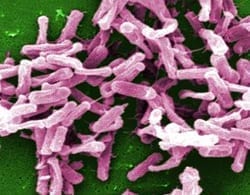Researchers from the Alberta Glycomics Centre at the University of Calgary and the University of Alberta, in collaboration with researchers at the National Research Council of Canada in Ottawa, have revealed the first molecular views showing how highly specific antibodies derived from llamas may provide a new method for controlling deadly infections from the opportunistic bacterial pathogen Clostridium difficile (C. difficile).
Published in the Journal of Biological Chemistry, the research reveals for the first time how antibodies recognize the disease’s two central toxin proteins – toxin A (TcdA) and toxin B (TcdB).
This new information provides exciting opportunities for creating a new generation of engineered antibodies that will be more effective at preventing the toxins from damaging the intestine during the normal course of the disease.
“Our research is an important step towards developing highly specific ways to treat this very common and serious disease,” says Kenneth Ng, associate professor in the Department of Biological Sciences at the University of Calgary and the study’s senior author.
C. difficile causes one of the most common and problematic hospital-acquired infections worldwide. The infection is primarily transmitted within healthcare facilities, and causes extreme diarrhea and potentially fatal colon inflammation.
A Canadian hospital study found that of 136,877 hospital admissions, 1 in 100 patients will contract C. difficile infection, and of those, 1 in 10 will die regardless of the initial reasons for admission. The disease is most frequently seen in older adults who take antibiotics and get medical care. Annual healthcare costs are estimated to be several billion dollars worldwide.
The key findings in the paper derive from the three-dimensional structures of antibody-toxin complexes that were determined using X-ray crystallography by Tomohiko Murase, Luiz Eugenio and Melissa Schorr in Dr. Ng’s laboratory.
The antibody-toxin complexes were developed using single-domain antibodies derived from llamas.
“The smaller size of the llama antibodies compared to the monoclonal antibodies currently used for diagnostics or in development for therapeutics greatly assists with structure determination and protein engineering,” explains Ng. “Starting from these structures, we are now creating modified antibodies for improving treatments in the future.”
“Basic biological research on llamas, camels and sharks led to the discovery of a smaller type of antibody with a simpler structure,” adds Ng. “It is this simpler structure that allows us to make modifications and perform many detailed studies that are not easily done with other types of antibodies.
The unique characteristics of these single-domain antibodies provide an attractive approach for developing new treatments for C. difficile.”
According to Ng, although the research is at the fundamental science level, the new structures provide a blueprint for designing new molecules that could neutralize the bacterial toxins more effectively than anything currently available.



